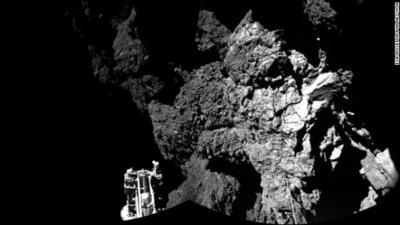Sat, Nov 15, 2014
Spacecraft's Harpoons Did Not Deploy, Now Apparently Lying On Its Side In A Crevice On The Comet's Surface
On Wednesday, Nov. 12, the European Space Agency's Rosetta mission successfully landed on the surface of comet 67P/Churyumov-Gerasimenko. Descending at a speed of about 2 mph the lander, called "Philae," first touched down and its signal was received at 11:03 a.m. EST.

Partially due to anchoring harpoons not firing, and the comet's low gravity (a hundred-thousand times less than that of Earth), Philae bounced off the surface and flew up to about six-tenths of a mile both above the comet's surface as well as downrange. At 12:53 p.m. EST, almost two hours after first contact, Philae again touched down. A second, more modest bounce resulted, again sending it airborne. Philae's third contact with the comet's nucleus was the charm. At 1 p.m. EST, the Rosetta mission's Philae lander became the first spacecraft to soft-land on a comet.
Rosetta mission controllers believe Philae alighted in a hole, or crevice, about six feet in diameter and six feet deep and that it is lying on its side. While the lander remains unanchored to the surface, it remains stable. and eight of its 10 instruments have already begun sending back data. The science team is working on its next moves.
"Philae is on the surface and doing a marvelous job, working very well, and we can say we have a very happy lander," said Paolo Ferri, ESA's head of mission operations at the European Space Operations Center, Darmstadt, Germany.
Teams are still working to confirm the location and the overall power and thermal situation on board. The lander did receive power from some of its solar panels. It appears that some parts of the lander were in shadow during the time that last night's surface telemetry data were being transmitted.
Launched in March 2004, Rosetta was reactivated in January 2014 after a record 957 days in hibernation. The mission consists of an orbiter and lander. Its objectives since arriving at comet 67P/Churyumov-Gerasimenko this summer have been to study the celestial object up close in unprecedented detail, and prepare for Philae's landing. The orbiter will continue tracking the comet's changes as it sweeps past the sun.
(Image provided by ESA)
More News
Aero Linx: Commercial Aviation Safety Team (CAST) Founded in 1997, the Commercial Aviation Safety Team (USCAST) has developed an integrated, data-driven strategy to reduce the comm>[...]
Land And Hold Short Operations Operations that include simultaneous takeoffs and landings and/or simultaneous landings when a landing aircraft is able and is instructed by the cont>[...]
We're Everywhere... Thanks To You! Even with the vast resources and incredibly far-reaching scope of the Aero-News Network, every now and then a story that should be reported on sl>[...]
Pilot’s Inadvertent Use Of The Landing Gear Control Handle Instead Of The Flaps Selector Switch During The Landing Rollout Analysis: The pilot reported that during the landin>[...]
Also: Cosmonaut Kicked Out, Airbus Scales Back, AF Silver Star, Russian A-60 Clobbered A Samaritan’s Purse humanitarian flight was hijacked on Tuesday, December 2, while atte>[...]
 ANN's Daily Aero-Linx (12.12.25)
ANN's Daily Aero-Linx (12.12.25) ANN's Daily Aero-Term (12.12.25): Land And Hold Short Operations
ANN's Daily Aero-Term (12.12.25): Land And Hold Short Operations ANN FAQ: How Do I Become A News Spy?
ANN FAQ: How Do I Become A News Spy? NTSB Final Report: Cirrus Design Corp SF50
NTSB Final Report: Cirrus Design Corp SF50 Airborne 12.08.25: Samaritans Purse Hijack, FAA Med Relief, China Rocket Fail
Airborne 12.08.25: Samaritans Purse Hijack, FAA Med Relief, China Rocket Fail



